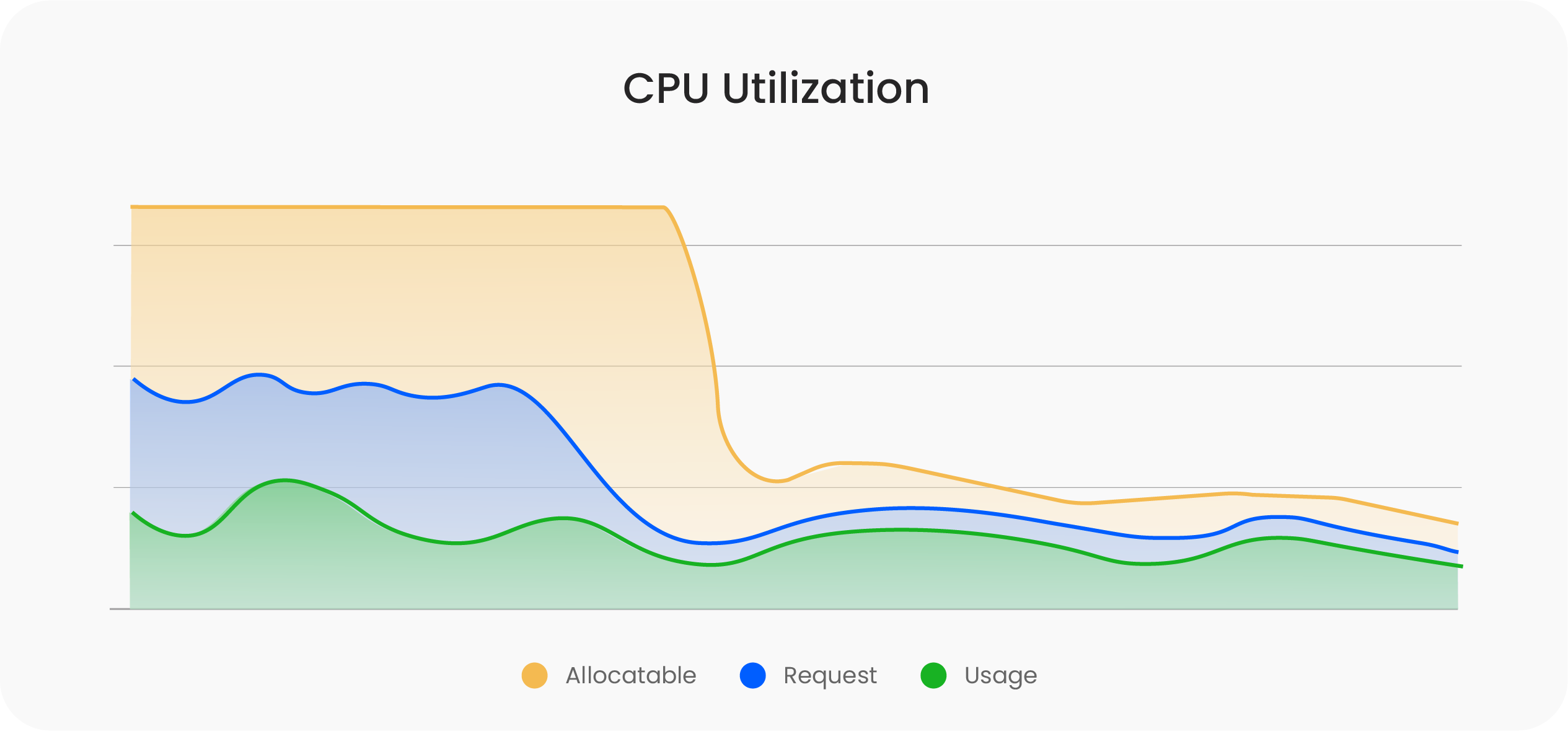Karpenterは柔軟性、パフォーマンス、シンプルさを備えた強力なKubernetesノードオートスケーラーです。スケジュールできないポッドに応じて自動的にコンピューティングリソースをプロビジョニングし、従来のクラスターオートスケーラーと比較して、より迅速なスケーリングとより良いリソース活用を可能にします。
しかし、多様なワークロードと動的なスポット価格を持つ本番環境で使用すると、チームは可用性リスクやコスト非効率が発生する非明示的なトレードオフに直面することがよくあります。
CloudPilot AIは、これらの高度な運用課題に対処するために設計されています。Kubernetes内のSREエージェントとして、オートスケーリングの基本原則に基づきながら、運用の複雑さを増すことなく、サービスの回復力を向上させ、クラウドコストを最適化するインテリジェントでコンテキストを認識する動作を追加します。
以下は、CloudPilot AIが重要なシナリオでKarpenterの動作をどのように改善するかの詳細な比較です。
1. 単一レプリカワークロードの高可用性
Karpenter:
統合やリバランス中、Karpenterは代替が完全にプロビジョニングされる前に単一レプリカポッドをホストするノードを終了させることがあり、たとえ短時間であってもサービスのダウンタイムを引き起こす可能性があります。

CloudPilot AI:
CloudPilot AIは新しいノードが準備完了し、ポッドが実行中であることが確認されるまでノードの終了を遅らせます。この優雅な引き継ぎメカニズムにより、キュー、データベース、ステートフルゲートウェイなどの重要なサービスの可用性が維持され、数秒のダウンタイムでも許容できない場合に対応します。

2. 予測的スポット中断緩和
Karpenter:
Karpenterは、AWSやその他のクラウドプロバイダーが提供する標準的な2分間のスポット中断通知に反応します。これは高負荷状況では不十分な場合があり、ポッドの退去遅延やスケジューリングの競合を引き起こす可能性があります。
CloudPilot AI:
CloudPilot AIのスポット予測エンジンは予測モデリングを使用して、最大45分前に中断信号を検出します。リスクの高いノードを事前に排出して置き換えることで、トラフィックスパイクやデプロイメントイベント中の中断の可能性を大幅に減少させます。

3. より高い回復力のためのインスタンスタイプの多様化
Karpenter:
Karpenterはコスト効率のために単一のインスタンスタイプを選択してワークロードをビンパッキングすることが多いです。パフォーマンスは良いものの、これによりインスタンスタイプのロックインが発生し、スポット価格の急騰やバッチ中断時のリスクが増大します。

CloudPilot AI:
CloudPilot AIは意図的にワークロードを複数のインスタンスタイプとアベイラビリティゾーンに分散させ、コスト効率と回復力のバランスを取ります。これにより特定のスポット市場への過度の依存を減らし、市場の変動時にクラスターの可用性を向上させます。
4. 自動アンチアフィニティ強制
Karpenter:
開発者がポッドのアンチアフィニティを定義しない限り、Karpenterは同じワークロードのレプリカを同じノード上に配置する可能性があります。これによりマルチレプリカサービスに単一障害点が生じる可能性があります。

CloudPilot AI:
CloudPilot AIはレプリカワークロードに対してデフォルトでアンチアフィニティポリシーを強制します。レプリカが少なくとも2つのノードに分散されるよう自動的に確保し、チームが複雑なアフィニティルールを手動で管理することなく高可用性を実現できるようサポートします。
5. より安全な統合のためのバランスの取れたワークロード配置
Karpenter:
Karpenterのビンパッキング戦略は、支出を最小限に抑えるために少数の大きなノードにワークロードを集中させる傾向があります。しかし、これらのノードが回収または再調整されると、結果として生じる中断は重大になる可能性があります。

CloudPilot AI:
CloudPilot AIはバランス優先の配置戦略を使用し、様々なサイズのノード全体にワークロードを分散させることで、ノード終了の影響を軽減し、より安全な統合イベントをサポートします。
6. ノードレベルのイベントログ
Karpenter:
Karpenterはイベントログを記録しますが、それらは散在しており解釈が困難です。ノードのライフサイクルに明確に紐づけられていないため、トラブルシューティングを始める際に手がかりがありません。
CloudPilot AI:
CloudPilot AIはKarpenterのログを、作成、削除、置換操作を含む明確なノードレベルのイベント履歴に整理します。各イベントにはステータス、理由、生データが付加され、トラブルシューティングを迅速に行い、すべての自動化の決定を信頼するためのコンテキストを提供します。

7. 永続ボリュームワークロードのためのインテリジェントなスケジューリング
Karpenter:
グループ内のPodが特定のアベイラビリティゾーンの永続ボリューム(PV)に依存している場合、Karpenterはグループ全体をそのゾーンにスケジュールします。ゾーンの容量が限られているか価格が高い場合、これによりコストが増加し、サービスの中断リスクが高まる可能性があります。
CloudPilot AI:
CloudPilot AIはPVに依存するPodを検出し、必要なゾーンにそれらのみをスケジュールします。残りは可用性の高い安価なゾーンに配置され、無駄を減らしスケーリングのボトルネックを回避します。
8. より柔軟なリソース割り当て
Karpenter:
Karpenterは実際のPodリソース使用量や制限設定を考慮しません。リクエストが誤って設定されていると、リソースの無駄や、統合中のOOM(メモリ不足)エラーのリスク増加につながる可能性があります。
CloudPilot AI:
CloudPilot AIには組み込みのワークロード最適化機能があります。使用パターンを継続的に分析し、あらゆるクラウドまたはオンプレミス環境でCPUとメモリの設定をリアルタイムで動的に調整します。
手動設定に頼る代わりに、CloudPilot AIは履歴データ、リアルタイムメトリクス、安全バッファを使用して、リソース requests を積極的に推奨し、微調整します — 過少利用と過剰プロビジョニングの両方を排除し、最高のパフォーマンスとコスト効率を実現します。

9.より直感的な可視化
Karpenter:
Karpenterはリソース状態とアクティビティログの表示にコマンドラインを使用しています。情報は断片化されており、簡単に視覚化できません。
CloudPilot AI:
リアルタイムのビジュアルダッシュボードを備えており、リソースの変更、イベントログ、月間支出、および過去のコスト傾向を統合し、インフラストラクチャのアクティビティを一目で明確に集中的に表示します。

結論
Karpenterは、Kubernetesに強力で柔軟なオートスケーリング機能をもたらします。しかし、急速に変化する環境で運用するチームにとって、ダウンタイムの1分や使用される1ドルが重要な場合、追加の自動化と知能のレイヤーがしばしば必要とされます。
CloudPilot AIはKubernetes内のSREエージェントとして機能し、ノードオートスケーリングの基盤の上に構築され、本番ワークロードの隠れた課題を解決します。予測的なスポット認識、スマートな配置、回復力のあるスケジューリングを組み合わせることで、組織がクラウドコスト最適化とオートスケーリングの安定性を大規模に達成するのを支援します。
CloudPilot AIがどのようにインフラストラクチャを安全に、コスト効率よく、自律的に数週間ではなく数分でスケールするのに役立つかをご覧ください。
開始するにはcloudpilot.aiにアクセスしてください。










